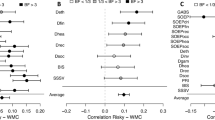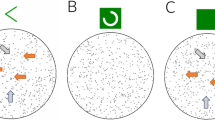Abstract
Risk perception has recently been shown to reveal a mental spatial representation, with people responding faster to low-risk items on the left side, and high-risk items on the right side. Subjective risk perception has a stronger spatial representation than objective risk perception; however, both reveal small effect sizes. With risk magnitude being a new domain within spatial mapping literature, we sought to explore its nuances. Following discussion surrounding the relationship between spatial mapping and level of expertise, this study investigated the effect of training an objective risk magnitude sequence on mental spatial representations. Participants (n = 34) used their left and right hands to indicate whether eight risk stimuli were lower or higher risk than a referent activity, both before and after training. Training involved repetitively learning the objectively correct order of the same eight risk stimuli for approximately 15 min. Pre-training results demonstrated the expected spatial representations. Contrary to our predictions, the spatial representation did not get stronger post-training, but instead disappeared. Previous research has demonstrated a loss of spatial-numerical mappings with increased task load. An increase in post-training reaction times could reflect an increase in task load due to a lack of adequate knowledge of risk stimulus order; thus revealing no mental spatial representation. However, failure to find training effects highlights the flexibility of weaker spatial representations, and supports research demonstrating spatial representation flexibility.



Similar content being viewed by others
References
Abrahamse E, van Dijck J-P, Fias W (2016) How does working memory enable number-induced spatial biases? Front Psychol 7:977
Ahmad N, Peterson N, Torella F (2015) The Micromort: a unit for comparing and communicating risk to patients. Int J Clin Pract 69:515–517
Bächtold D, Baumüller M, Brugger P (1998) Stimulus-response compatibility in representational space. Neuropsychologia 36:731–735
Blastland M, Spiegelhalter D (2014) The Norm chronicles: stories and numbers about danger and death. Basic Books, New York
Cho YS, Bae GY, Proctor RW (2012) Referential coding contributes to the horizontal SMARC effect. J Exp Psychol Hum Percept Perform 38:726–734
Cipora K, Hohol M, Nuerk H-C, Willmes K, Brożek B, Kucharzyk B, Nęcka E (2016) Professional mathematicians differ from controls in their spatial-numerical associations. Psychol Res 80:710–726
Cipora K, Schroeder PA, Soltanlou M, Nuerk H-C (2018) More space, better mathematics: is space a powerful tool or a cornerstone for understanding arithmetic? In: Mix K, Battista M (eds) Visualizing mathematics. Springer, Cham, pp 77–116
Dehaene S (1992) Varieties of numerical abilities. Cognition 44:1–42
Dehaene S, Bossini S, Giraux P (1993) The mental representation of parity and number magnitude. J Exp Psychol Gen 122:371–396
Didino D, Breil C, Knops A (2019) The influence of semantic processing and response latency on the SNARC effect. Acta Physiol (Oxf) 196:75–86
Fias W, van Dijck J-P (2016) The temporary nature of number—space interactions. Can J Exp Psychol 70:33–40
Fischer MH, Mills RA, Shaki S (2010) How to cook a SNARC: number placement in text rapidly changes spatial-numerical associations. Brain Cogn 72:333–336
Fischer U, Moeller K, Bientzle M, Cress U, Nuerk H-C (2011) Sensori-motor spatial training of number magnitude representation. Psychon Bull Rev 18:177–183
Fry A, Harrison A, Daigneault M (2016) Micromorts-what is the risk? Br J Oral Maxillofac Surg 54:230–231
Georges C, Schiltz C, Hoffmann D (2015) Task instructions determine the visuospatial and verbal-spatial nature of number-space associations. Q J Exp Psychol 68:1895–1909
Gevers W, Reynvoet B, Fias W (2003) The mental representation of ordinal sequences is spatially organized. Cognition 87:B87–B95
Ginsburg V, Gevers W (2015) Spatial coding of ordinal information in short-and long-term memory. Front Hum Neurosci 9:8
Ginsburg V, Van Dijck J-P, Previtali P, Fias W, Gevers W (2014) The impact of verbal working memory on number-space associations. J Exp Psychol Learn Mem Cogn 40:976–986
Ginsburg V, Archambeau K, van Dijck J-P, Chetail F, Gevers W (2017) Coding of serial order in verbal, visual and spatial working memory. J Exp Psychol Gen 146:632
Gut M, Staniszewski R (2016) The SNARC effect in number memorization and retrieval. What is the impact of congruency, magnitude and the exact position of numbers in short-term memory processing? Adv Cogn Psychol 12:193–208
Herrera A, Macizo P, Semenza C (2008) The role of working memory in the association between number magnitude and space. Acta Physiol (Oxf) 128:225–237
Hoffmann D, Hornung C, Martin R, Schiltz C (2013) Developing number-space associations: SNARC effects using a color discrimination task in 5-year-olds. J Exp Child Psychol 116:775–791
Hoffmann D, Mussolin C, Martin R, Schiltz C (2014) The impact of mathematical proficiency on the number-space association. PLoS One 9:e85048
Holmes KJ, Lourenco SF (2011) Common spatial organization of number and emotional expression: a mental magnitude line. Brain Cogn 77:315–323
Keage HA, Loetscher T (2018) Estimating everyday risk: subjective judgments are related to objective risk, mapping of numerical magnitudes and previous experience. PLoS One 13:e0207356
Knight FH (1921) Risk, uncertainty and profit. Hart, Schaffner and Marx, New York
Kucian K, Grond U, Rotzer S et al (2011) Mental number line training in children with developmental dyscalculia. NeuroImage 57:782–795
Li M, Lv H, Abdukerim Z, Zhang Y, Qiao F, Li Q (2016) Verbal-spatial and visuospatial coding of the SNARC effect: a comparative study in cultures with different reading directions. Percept Mot Skills 123:17–32
Lindemann O, Alipour A, Fischer MH (2011) Finger counting habits in middle eastern and western individuals: an online survey. J Cross Cult Psychol 42:566–578
Loudwin J, Bannert M (2017) Facing pitch: constructing associations between space and pitch leads to better estimation of musical intervals. Music Sci 21:26–40
Macnamara A, Keage HAD, Loetscher T (2018) Mapping of non-numerical domains on space: a systematic review and meta-analysis. Exp Brain Res 236:335–346
Macnamara A, Loetscher T, Keage HAD (2019) Judging risk magnitude: walking to the left and base jumping to the right. Exp Brain Res 237:653–662. https://doi.org/10.1007/s00221-018-5449-2
McCrink K, Shaki S (2016) Culturally inconsistent spatial structure reduces learning. Acta Physiol (Oxf) 169:20–26
Mohr PN, Biele G, Heekeren HR (2010) Neural processing of risk. J Neurosci 30:6613–6619
Moyer RS, Landauer TK (1967) Time required for judgements of numerical inequality. Nature 215:1519–1520
Nicholls MER, Thomas NA, Loetscher T, Grimshaw GM (2013) The Flinders Handedness survey (FLANDERS): a brief measure of skilled hand preference. Cortex 49:2914–2926. https://doi.org/10.1016/j.cortex.2013.02.002
Nuerk H-C, Wood G, Willmes K (2005) The universal SNARC effect: the association between number magnitude and space is amodal. Exp Psychol 52:187–194
Nuerk H-C, Patro K, Cress U, Schild U, Friedrich CK, Göbel SM (2015) How space-number associations may be created in preliterate children: six distinct mechanisms. Front Psychol 6:215
Previtali P, de Hevia MD, Girelli L (2010) Placing order in space: the SNARC effect in serial learning. Exp Brain Res 201:599–605
Psychology Software Tools Inc. [E-Prime 2.0] (2012). http://www.pstnet.com. Accessed 9 Apr 2018
Selya AS, Rose JS, Dierker LC, Hedeker D, Mermelstein RJ (2012) A practical guide to calculating Cohen’s f2, a measure of local effect size, from PROC MIXED. Front Psychol 3:111
Soreide K, Ellingsen CL, Knutson V (2007) How dangerous is BASE jumping? An analysis of adverse events in 20,850 jumps from the Kjerag Massif, Norway. J Trauma Acute Care Surg 62:1113–1117
Spiegelhalter D (2014) The power of the MicroMort. BJOG 121:662–663
Spiegelhalter D (2017) Risk and uncertainty communication. Annu Rev Stat Appl 4:31–60
van Dijck J-P, Fias W (2011) A working memory account for spatial-numerical associations. Cognition 119:114–119
Van Opstal F, Fias W, Peigneux P, Verguts T (2009) The neural representation of extensively trained ordered sequences. Neuroimage 47:367–375
Verguts T, Fias W, Stevens M (2005) A model of exact small-number representation. Psychon Bull Rev 12:66–80
Wood G, Willmes K, Nuerk H-C, Fischer MH (2008) On the cognitive link between space and number: a meta-analysis of the SNARC effect. Psychol Sci 50:489–525
Author information
Authors and Affiliations
Corresponding author
Ethics declarations
Conflict of interest
The authors declare that they have no conflict of interest.
Additional information
Publisher's Note
Springer Nature remains neutral with regard to jurisdictional claims in published maps and institutional affiliations.
Appendices
Appendix 1
See Table 3.
Appendix 2
See Table 4.
Appendix 3
See Table 5.
Rights and permissions
About this article
Cite this article
Ghezzi, E.S., Loetscher, T., Macnamara, A. et al. The effects of risk magnitude training on mapping risks on space. Exp Brain Res 237, 2789–2798 (2019). https://doi.org/10.1007/s00221-019-05632-w
Received:
Accepted:
Published:
Issue Date:
DOI: https://doi.org/10.1007/s00221-019-05632-w




